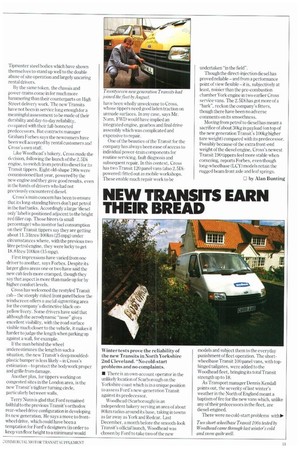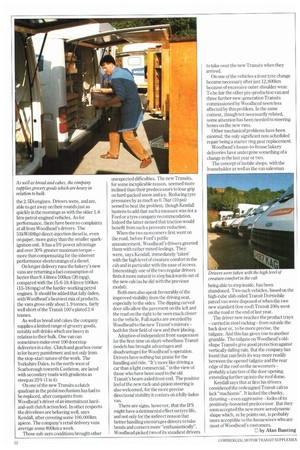NEW TRANSITS EARN THEIR BREAD
Page 111

Page 112

If you've noticed an error in this article please click here to report it so we can fix it.
Winter tests prove the reliability of the new Transits in North Yorkshire 2nd Cleveland. "No cold-start problems and no complaints.
MI There is an own-account operator in the unlikely location of Scarborough on the Yorkshire coast which is in a unique position to assess Ford's new-generation Transit against its predecessor.
Woodhead (Scarborough) is an independent bakery serving an area of about 80km radius around its base, taking in towns as far away as York and Redcar. Last December, a month before the smooth-look Transit's official launch, Woodhead was chosen by Ford to take two of the new
models and subject them to the everyday punishment of fleet operation. The shortwheelbase Transit 100 panel vans, with tophinged tailgates, were added to the Woodhead fleet, bringing its total Transit strength up to 18.
As Transport manager Dennis Kendall points out, the severity of last winter's weather in the North of England meant a baptism of fire for the new vans which, unlike any of their prdecessors in the fleet, are diesel-engined.
There were no cold-start problems with the 2.5Di engines. Drivers were, and are, able to get away on their rounds just as quickly in the mornings as with the older 1.6 litre petrol-engined vehicles. As for performance, there have been no complaints at all from Woodhead's drivers. The 51kW(68hp) direct-injection diesel is, even on paper, more gutsy than the smaller sparkignition unit It has a 5% power advantage and over 30% greater maximum torque — more than compensating for the inherent performance shortcomings of a diesel.
On longer delivery runs the bakery's new vans are returning a fuel consumption of better than 9.4 litres/100km (30 mpg), compared with the 15.6-18.8 litres/100km (15-18 mpg) of the harder-working petrol engines. It should be added that fully-laden, with Woodhead's heaviest mix of products, the vans gross only about 1.9 tonnes, fairly well short of the 'Transit 100's plated 2.6 tonnes.
As well as bread and cakes the company supplies a limited range of grocery goods, notably soft drinks which are heavy in relation to their bulk. One van can sometimes make over 100 doorstep deliveries in a day. Clutch and gearbox come in for heavy punishment and not only from the stop-start nature of the work. The Yorkshire Dales, to the north-west of Scarborough towards Castleton, are laced with secondary roads with gradients as steep as 25% (1 in 4).
On one of the new Transits a clutch quadrant in the pedal mechanism has had to be replaced, after compaints from Woodhead's driver of an intermittent hardand-soft clutch action feel. In other respects the drivelines are behaving well, says Kendall, after covering some 100, 000km apiece. The company's retail delivery vans average some 800km a week.
Those sub-zero conditions brought other unexpected difficulties. le new Transits, for some inexplicable reason, seemed more inclined than their predecessors to lose grip on hard-packed snow and ice. Reducing tyre pressures by as much as 0. 7bar (10 psi) semed to beat the problem, though Kendall hastens to add that such a measure was not a Ford or a tyre company recommendation. Indeed the latter denied that traction would benefit from such a pressure reduction.
When the two newcomers first went on the road, before Ford's public announcement, Woodhead's drivers greeted them with rather mixed feelings. They were, says Kendall, immediately 'taken' with the high level of creature comfort in the cab and in particular with the ease of access. Interestingly one of the two regular drivers finds it more natural to step backwards out of the new cab (as he did with the previous model).
Both men also speak favourably of the improved visibility from the driving seat, especially to the sides. The dipping curved door sills allow the pavement on the left and the road on the right to be seen much closer to the vehicle. Full marks are awarded by Woodhead to the new Transit's mirrors — both for their field of view and their 'placing.
Adoption of independent front suspension for the first time on short-wheelbase Transit models has brought advantages and disadvantaged for Woodhead's operation. Drivers have nothing but praise for the handling and ride. "It's more like driving a car than a light commercial," in the view of those who have been used to the old Transit's beam-axled front end. The positive feel of the new rack-and-pinion steering is also welcomed, for the more precise directional stability it confers on a fully-laden van.
There are signs, however, that the IFS might have a detrimental effect on tyre life, and not only for the indirect reason that better handling encourages drivers to take bends and corners more "enthusiastically". Woodhead picked two of its steadiest drivers to take over the new Transits when they arrived.
On one of the vehicles a front tyre change became necessary after just 12,800km because of excessive outer shoulder wear. To be fair the other pre-production van and three further new-generation Transits commissioned by Woodhead seem less affected by this problem. In the same context, though not necessarily related, some attention has been needed to steering boxes on the new vans.
Other mechanical problems have been minimal; the only significant non-scheduled repair being a starter ring gear replacement.
Woodhead's house-to-house bakery deliveries have undergone something of a change in the last year or two.
The concept of mobile shops, with the householder as well as the van salesman being able to step inside, has been abandoned. Two such vehicles, based on the high-cube slab-sided Transit Dormobile parcel van were disposed of when the two new standard (low roof) Transit 100s went on the road at the end of last year.
The driver now reaches the product trays — carried in steel racking — from outside the back door or, to be more precise, the tailgate. And this has given rise to another grumble. The tailgate on Woodhead's oldshape Transits give good protection against vertically-falling rain. But the company has found that rain finds its way more readily between the opened tailgate and the rear edge of the roof on the newcomers — probably a function of the door opening extending further up into the roof dome.
Kendall says that at first his drivers considered the redesigned Transit cab to lack "machismo". It lacked the chunky, thrusting — even aggressive — looks of its positively-bonneted predecessor. But they soon accepted the new more aerodynamic shape which, as he points out, is probably more acceptible to the haouewives who are most of Woodhead's customers.
E by Alan Bunting
























































































































